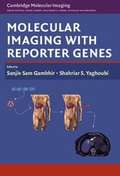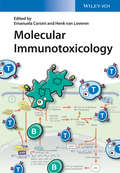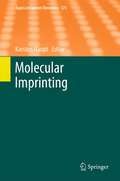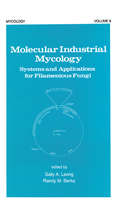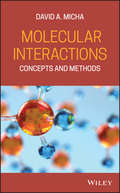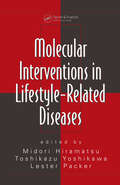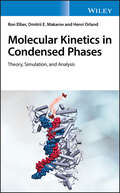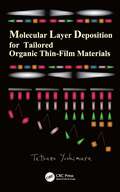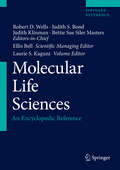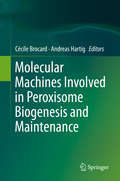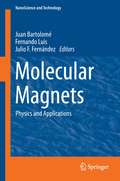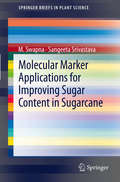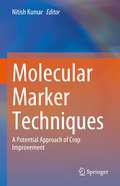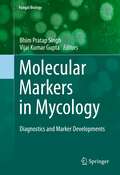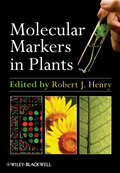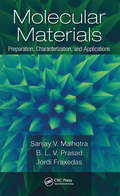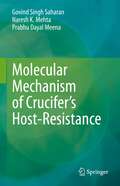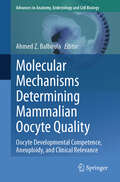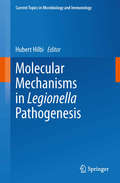- Table View
- List View
Molecular Imaging with Reporter Genes
by Sanjiv Sam Gambhir Shahriar S. YaghoubiReporter genes have been used for several decades to study regulation of gene expression in vivo. However, it was little more than a decade ago that a new class of reporter genes was developed for imaging molecular events within living subjects. By following the interactions of protein molecules, researchers can resolve the complex chemical pathways that living cells utilise. This book focuses on this group of imaging reporter genes, starting with detailed descriptions of all reporter genes from different imaging modalities, including optical, MRI, and radionuclide-based imaging. Key scientists in the field explain how to enhance reporter gene imaging utility through instrumentation and the various applications of this technology. This is the first comprehensive book on all aspects of reporter gene imaging, detailing what is known in the field and future goals for research. Investigators in biomedical sciences, physicians, and the biotechnology and pharmaceutical industries will benefit from topics covered.
Molecular Immunotoxicology
by Emanuela Corsini Henk Van LoverenThe first comprehensive reference on immunotoxicology using analyses based on molecular effects rather than on animal models. Following an introduction to immune system pathways and toxicity mechanisms from a systemic perspective, the main part of the book surveys individual molecular mechanisms of important immunotoxicants, from PAHs to biopharmaceuticals, and from receptor-mediated toxicity to nanoparticle toxicity. Taken together, the knowledge presented here provides an up-to-date overview of this hot topic that can be directly applied to the prediction and characterization of immunotoxic effects in drugs, chemicals, and environmental contaminants.
Molecular Imprinting
by Karsten HauptMolecularly Imprinted Polymers, by Karsten Haupt, Ana V. Linares, Marc Bompart und Bernadette Tse Sum Bui.- Physical Forms of MIPs, by Andrea Biffis, Gita Dvorakova und Aude Falcimaigne-Cordin.- Micro and Nanofabrication of Molecularly Imprinted Polymers, by Marc Bompart, Karsten Haupt und Cédric Ayela.- Immuno-Like Assays and Biomimetic Microchips, by M. C. Moreno-Bondi, M. E. Benito-Peña, J. L. Urraca und G. Orellana.- Chemosensors Based on Molecularly Imprinted Polymers, by Subramanian Suriyanarayanan, Piotr J. Cywinski, Artur J. Moro, Gerhard J. Mohr und Wlodzimierz Kutner.- Chromatography, Solid-Phase Extraction, and Capillary Electrochromatography with MIPs, by Blanka Tóth und George Horvai.- Microgels and Nanogels with Catalytic Activity, by M. Resmini, K. Flavin und D. Carboni.
Molecular Imprinting of Polymers
by Sergey PiletskyOne of Nature's most important talents is evolutionary development of systems capable of molecular recognition: distinguishing one molecule from another. Molecular recognition is the basis for most biological processes, such as ligandreceptor binding, substrate-enzyme reactions and translation and transcription of the genetic code and is therefore
Molecular Industrial Mycology: Systems and Applications for Filamentous Fungi (Mycology Ser. #8)
by LeongTen articles provide an overview of the recently flowering research into the genetics and molecular biology of fungus species that are economically significant in industry. The contributors, from a variety of disciplines, report on work in such areas as industrial enzymes, antibiotics, toxins, heter
Molecular Interactions: Concepts and Methods
by David A. MichaA modern, comprehensive text and reference describing intermolecular forces, this book begins with coverage of the concepts and methods for simpler systems, then moves on to more advanced subjects for complex systems – emphasizing concepts and methods used in calculations with realistic models and compared with empirical data. Contains applications to many physical systems and worked examples Proceeds from introductory material to advanced modern treatments Has relevance for new materials, biological phenomena, and energy and fuels production
Molecular Interventions for Developing Climate-Smart Crops: A Forage Perspective
by Shahid Ahmed Rajesh Kumar Singhal Saurabh Pandey Subhash ChandThis edited book is collection of information on molecular interventions needed for climate-resilient forage crops. The main focus is to address the gap in the advanced scientific knowledge for the forage species. Agriculture is extremely vulnerable to climate, and even slight change in climatic factors such as temperature causes tremendous losses in yield potential. Forage crops are crucial in global food security and environmental sustainability and face several environmental challenges in field conditions. However, the research on forage crops is far-off compared to agricultural crops and causes a substantial gap in forage demand and productivity. Further, this gap is directly associated with animal health, reproduction, and productivity. Abiotic stresses mainly affect the plant's crucial processes, ultimately reducing the final yield. The problem of abiotic stresses is more frequent in forage crops as they are growing and cultivated in less productive soil and harsh conditions. This book discusses current aspects of crucial physiological, biochemical and molecular processes in forage crops, which are essential for forage crops improvement. The text's major focus is on the advanced technologies and approaches such as seed priming, bio-fortification, breeding, omics, transgenic and bioengineering of metabolic pathways in unique ways, which helps us develop innovative solutions for forage crops. This book covers all the crucial advance technologies, which help mitigate the abiotic stresses in forage crops. We believe that this book will initiate and introduce the readers to state-of-the-art developments and unique in this field of study. This book is of interest to teachers, researchers, climate change scientists, capacity builders, and policymakers. Also, the book serves as additional reading material for undergraduate and graduate students of agriculture, forestry, ecology, soil science, and environmental sciences. National and international agricultural scientists and policymakers will also find this a worthwhile read.
Molecular Interventions in Lifestyle-Related Diseases
by Toshikazu Yoshikawa Lester Packer Midori HiramatsuThe Japanese Ministry of Health, Labor and Welfare, officially recognizing that various risk factors for disease are present in our environment, has proposed the concept of lifestyle-related diseases. These include those diseases that are tied to such lifestyle choices as excessive alcohol consumption, cigarette smoking, exposure to stress, and poo
Molecular Kinetics in Condensed Phases: Theory, Simulation, and Analysis
by Ron Elber Dmitrii E. Makarov Henri OrlandA guide to the theoretical and computational toolkits for the modern study of molecular kinetics in condensed phases Molecular Kinetics in Condensed Phases: Theory, Simulation and Analysis puts the focus on the theory, algorithms, simulations methods and analysis of molecular kinetics in condensed phases. The authors – noted experts on the topic – offer a detailed and thorough description of modern theories and simulation methods to model molecular events. They highlight the rigorous stochastic modelling of molecular processes and the use of mathematical models to reproduce experimental observations, such as rate coefficients, mean first passage times and transition path times. The book’s exploration of simulations examines atomically detailed modelling of molecules in action and the connections of these simulations to theory and experiment. The authors also explore the applications that range from simple intuitive examples of one- and two-dimensional systems to complex solvated macromolecules. This important book: Offers an introduction to the topic that combines theory, simulation and analysis Presents a guide written by authors that are well-known and highly regarded leaders in their fields Contains detailed examples and explanation of how to conduct computer simulations of kinetics. A detailed study of a two-dimensional system and of a solvated peptide are discussed. Discusses modern developments in the field and explains their connection to the more traditional concepts in chemical dynamics Written for students and academic researchers in the fields of chemical kinetics, chemistry, computational statistical mechanics, biophysics and computational biology, Molecular Kinetics in Condensed Phases is the authoritative guide to the theoretical and computational toolkits for the study of molecular kinetics in condensed phases.
Molecular Layer Deposition for Tailored Organic Thin-Film Materials (Optics and Photonics)
by Tetsuzo YoshimuraThis book provides concepts and experimental demonstrations for various types of molecular layer deposition (MLD) and organic multiple quantum dots (organic MQDs), which are typical tailored organic thin-film materials. Possible applications of MLD to optical interconnects, energy conversion systems, molecular targeted drug delivery, and cancer therapy are also proposed. First, the author reviews various types of MLD processes including vapor-phase MLD, liquid-phase MLD, and selective MLD. Next, he introduces organic MQDs, which are typical tailored organic thin-film materials produced by MLD. The author then describes the design of light modulators/optical switches, predicts their performance, and discusses impacts of the organic MQDs on them. He then also discusses impacts of the organic MQDs on optical interconnects within computers and on optical switching systems. Finally, the author presents MLD applications to molecular targeted drug delivery, photodynamic therapy, and laser surgery for cancer therapy. This book is intended for researchers, engineers, and graduate students in optoelectronics, photonics, and any other field where organic thin-film materials can be applied.
Molecular Life Sciences
by Judith Klinman Robert D. Wells Judith S. Bond Bettie Sue Siler MastersThe Encyclopedia examines biological phenomena at the molecular level and their interactions that govern life processes. Covers genes and genomes; protein structure and function; unifying concepts from biology, chemistry, mathematics and physics and more.
Molecular Machines Involved in Peroxisome Biogenesis and Maintenance
by Cecile Brocard Andreas HartigIn eukaryotes, lipid metabolism requires the function of peroxisomes. These multitasking organelles are also part of species-specific pathways such as the glyoxylate cycle in yeast and plants or the synthesis of ether lipid in mammals. Proteins required for the biogenesis of peroxisomes typically assemble in large molecular complexes, which participate in membrane formation, protein transport, peroxisome duplication and - inheritance during cell division. Peroxisomal function is essential for life. Mutations in PEX genes, encoding for biogenesis factors, are often associated with lethal disorders. The association of peroxisomes with other organelles suggests an extensive participation in organellar crosstalk. This book represents a state-of-the-art review in the field of peroxisome research encompassing the cell and molecular biology of peroxisome biogenesis and its diseases, the protein complexes involved in this process and the modern technologies applied to study them. The book is intended for graduate students, researchers and lecturers in biochemistry, molecular and cell biology with a biomedical background.
Molecular Machines and Motors
by Alberto Credi Serena Silvi Margherita VenturiThe cutting-edge advances in this research field are nicely pictured in the chapters of this volume. They come from world's leading laboratories engaged in the development of molecular machines and are authored by some of the most respected scientists in the field. This volume shows, on the one hand, the level of ingenuity and technical capability reached in the construction of artificial nanomachines roughly two decades after their inception. On the other hand, it conveys the excitement about the enormous opportunities as well as the challenges this research area presents, as the interest of researchers is shifting from ensemble to single-molecule measurements and from homogeneous to heterogeneous environments. Indeed, as Feynman said "when we have some control of the arrangement of things on a molecular scale, we will get an enormously greater range of possible properties that substances can have. " Although the answer to the "when" question is not easy to find, there is no doubt that artificial molecular machines and motors will lead to a wide variety of applications which we cannot even envisage today. The Nobel Prize in Chemistry 2016 was awarded jointly to Jean-Pierre Sauvage, Sir J. Fraser Stoddart and Bernard L. Feringa "for the design and synthesis of molecular machines". Both Jean-Pierre Sauvage and Bernard L. Feringa contributed to this volume. The goal of each thematic volume in this series is to give the non-specialist reader, whether in academia or industry, a comprehensive insight into an area where new research is emerging which is of interest to a larger scientific audience. Each review within the volume critically surveys one aspect of that topic and places it within the context of the volume as a whole. The most significant developments of the last 5 to 10 years are presented using selected examples to illustrate the principles discussed. The coverage is not intended to be an exhaustive summary of the field or include large quantities of data, but should rather be conceptual, concentrating on the methodological thinking that will allow the non-specialist reader to understand the information presented. Contributions also offer an outlook on potential future developments in the field. Review articles for the individual volumes are invited by the volume editors. Readership: research chemists at universities or in industry, graduate students.
Molecular Machines in Biology
by Joachim FrankThe concept of molecular machines in biology has transformed the medical field in a profound way. Many essential processes that occur in the cell, including transcription, translation, protein folding and protein degradation, are all carried out by molecular machines. This volume focuses on important molecular machines whose architecture is known and whose functional principles have been established by tools of biophysical imaging (X-ray crystallography and cryo-electron microscopy) and fluorescence probing (single-molecule FRET). This edited volume includes contributions from prominent scientists and researchers who understand and have explored the structure and functions of these machines. This book is essential for students and professionals in the medical field who want to learn more about molecular machines.
Molecular Magnetochemistry
by Sergey Vulfson PhDInvestigating the relationship between the magnetic properties and structure of molecules, molecular magnetochemistry, is an area of growing interest to scientists in a variety of fields, including physical, organic and inorganic chemistry, molecular physics, and biophysics. For the first time, systematic results on magnetic properties of molecules such as mean magnetic susceptibility, their anisotropies and principal magnetic axes are presented. Molecular Magnetochemistry is a comprehensive and up-to-date view on experimental methods not covered in previous volumes, including the Zeeman effect in vapor phase and magnetic birefringence of diamagnetic systems (Cotton-Mouton Effect). The relationship between magnetic and related electrical phenomena is also described, summing up experimental data on magnetic and electrical anisotropies and components of molecular quadrupole moments.
Molecular Magnets
by Juan Bartolomé Fernando Luis Julio F. FernándezThis book provides an overview of the physical phenomena discovered in magnetic molecular materials over the last 20 years. It is written by leading scientists having made the most important contributions to this active area of research. The main topics of this book are the principles of quantum tunneling and quantum coherence of single-molecule magnets (SMMs), phenomena which go beyond the physics of individual molecules, such as the collective behavior of arrays of SMMs, the physics of one-dimensional single-chain magnets and magnetism of SMMs grafted on substrates. The potential applications of these physical phenomena to classical and quantum information, communication technologies, and the emerging fields of molecular spintronics and magnetic refrigeration are stressed. The book is written for graduate students, researchers and non-experts in this field of research.
Molecular Male Reproductive Medicine: Biology and Clinical Perspectives (Advances in Experimental Medicine and Biology #1469)
by C. Yan Cheng Fei SunThis book bridges the gap of basic research in male reproductive biology and its relationship to clinical studies. Bringing together a group of senior investigators with decades of experience in research and clinical investigation and keen interest in collaboration between the two areas, this book provides a balanced treatment of technical and basic research insights and cutting-edge findings, while introducing new ideas for clinical applications of this research. Section I is devoted to clinical aspects including testis biology, prostate biology, and spermatogenesis by senior investigators of male infertility treatment, particularly non-obstructive azoospermia. Section II presents the latest findings in male reproductive biology from a basic research perspective, as well as covering cutting-edge technology such as scRNA-Seq, scATAC-Seq, DNA chromatic accessibility and organization studies, genetic models, cell biology, molecular biology, and biochemistry on testis biology, and spermatogenesis. This book offers not only a cohesive summary of new findings and concepts in basic and clinical male reproductive research, it analyzes and assembles these concepts into a roadmap for the next decade of translational research, bringing lab discoveries to the bedside.
Molecular Marker Applications for Improving Sugar Content in Sugarcane
by M. Swapna Sangeeta SrivastavaSugarcane, an important source of sugar, plays a substantial role in world economy. As a C4 plant this has very efficient system for carbohydrate metabolism through photosynthesis. Crop improvement efforts have concentrated mainly on improving quality traits, mainly sugar content. This being a complex trait, involves a large number of target genes in the metabolic pathway. The complex polyploid nature of the crop makes it more difficult to pin point the key players in this complex pathway. Despite its importance, little is known about the exact mechanism of sucrose accumulation and its regulation in sugarcane. Many enzymes have been proposed to have a key role in determining the ultimate sucrose content in sugarcane. There are evidences to show that some of these like Sucrose Phosphate Synthase (SPS) and Sucrose Synthase (SuSy) are encoded by multiple genes that show organ specifity in sugarcane. Especially in a crop like sugarcane where the classical techniques are of limited help in elucidating various genetic complexities, molecular techniques can be of help in throwing some light on the grey areas. Molecular marker strategies will be of help in understanding some aspects of sucrose metabolism and its regulation in this crop, thus complementing the ongoing crop improvement programmes.
Molecular Marker Techniques: A Potential Approach of Crop Improvement
by Nitish KumarThis edited book covers the applications of molecular markers in the genetic improvement of crop plants. Recent advances in molecular marker techniques such as the development of high-throughput genotyping platforms, marker-assisted selection, and non-coding RNA-based markers have been discussed. Essential information is provided on functional markers, genotype-by-sequencing, and association mapping methodologies that can facilitate accelerated crop breeding programs for increased yield, high nutritional quality, and tolerance to a variety of abiotic and biotic stresses. This volume presents basic information on molecular marker techniques from marker location up to gene cloning. The book includes a description of technical approaches in genome analysis such as comparison of marker systems, positional cloning, and array techniques. This book is of interest to teachers, researchers, and plant breeders. The book also serves as additional reading material for undergraduate and graduate students of agriculture, horticulture, and forestry.
Molecular Markers in Mycology: Diagnostics and Marker Developments (Fungal Biology)
by Vijai Kumar Gupta Bhim Pratap SinghThe Kingdom fungi encompass a massive diversity of taxa with wide-ranging ecologies, life cycles, and morphologies ranging from unicellular aquatic chytrids to large mushrooms. Before molecular methods came in existence, taxonomists considered this Kingdom to be a member of the plant kingdom due to certain life styles like immobility and growth habitats. Molecular markers (also known as DNA markers), facilitated a better alternative method over traditional morphological methods, employed for the identification, characterization, and to understand the evolution of fungi. The morphological methods used for identification are mainly dependent on spore color or microscopic features whereas molecular markers are based on DNA polymorphism in the genomic organization. Phylogenetic studies reported in last decade, based on molecular markers, have reshaped the classification system of Kingdom fungi, which divided into one subkingdom, seven phyla, and ten subphyla. Recent advances in molecular mycology have opened the way for researchers to identify and characterize novel fungal species from unique environments. Mycology is concerned with the systematic study of fungi, including their genetic and biochemical properties, their use to humans as a source of medicine and food, as well as their dangers, such as poisoning and infections. In the 21st century with the development of DNA sequencing technologies and phylogenetic analysis based on molecular markers, new insights into fungal taxonomy were provided. This book contains a thorough discussion of molecular characterization and detection of different groups of fungi by using PCR-based markers and provides a comprehensive view of the applications and uses of different molecular markers in molecular mycology. It also addresses the recent molecular markers employed to solve the problems of identification and discusses current approaches used in molecular characterization and detection of fungi.
Molecular Markers in Plants
by Robert J. HenryMolecular Markers in Plants surveys an array of technologies used in the molecular analysis of plants. The role molecular markers play in plant improvement has grown significantly as DNA sequencing and high-throughput technologies have matured. This timely review of technologies and techniques will provide readers with a useful resource on the latest molecular technologies.Molecular Markers in Plants not only reviews past achievements, but also catalogs recent advances and looks forward towards the future application of molecular technologies in plant improvement. Opening chapters look at the development of molecular technologies. Subsequent chapters look at a wide range of applications for the use of these advances in fields as diverse as plant breeding, production, biosecurity, and conservation. The final chapters look forward toward future developments in the field.Looking broadly at the field of molecular technologies, Molecular Markers in Plants will be an essential addition to the library of every researcher, institution, and company working in the field of plant improvement.
Molecular Materials: Preparation, Characterization, and Applications
by Sanjay Malhotra B. L. Prasad Jordi FraxedasThe field of molecular materials research looks at the preparation and characterization of potentially useful materials with enhanced physical, chemical, and biomedical properties. Molecular Materials: Preparation, Characterization, and Applications discusses the cutting-edge interdisciplinary research in the area of advanced molecular-based materials. This book explores multiple aspects of molecular materials, including their synthesis and characterization, and gives information on their application in various fields.
Molecular Mechanism of Crucifer’s Host-Resistance
by Govind Singh Saharan Prabhu Dayal Meena Naresh K. MehtaThe book is a comprehensive compilation of applied knowledge for developing resistant varieties to all the major biotrophs, hemibiotrophs and necrotrophs pathogens of crucifers through the use of latest biotechnological approaches. The book includes, multi-component resistance, incorporation of non-host resistance gene, function of particular gene in resistance, expression of age related resistance, enhanced gene resistance, sources of alternative gene which enhance disease resistance, through the use of latest biotechnical approaches like proteomics, omics, transcriptomics and metabolomics. The book also explores the molecular basis of disease resistance, its biometabolomics activities in response to infection and interaction by the various biotrophs, hemibiotrophs and necrotrophs pathogens. The identification of R genes and its incorporation into agronomically superior varieties through use of molecular mechanisms is also explained. This compilation is immensely useful to the researchers especially Brassica breeders, teachers, extension specialists, students, industrialists, farmers, and all others who are interested to grow healthy, and profitable cruciferous crops all over the world.
Molecular Mechanisms Determining Mammalian Oocyte Quality: Oocyte Developmental Competence, Aneuploidy, and Clinical Relevance (Advances in Anatomy, Embryology and Cell Biology #238)
by Ahmed Z. BalboulaAs the age of childbearing increases, reduced female gamete (egg) quality has emerged as the primaery cause of infertility in women. This book addresses molecular mechanisms that regulate oocyte quality as well as intrinsic and extrinsic factors that compromise these mechanisms. Eggs are produced through a unique cell division called meiosis. Oocyte meiosis is initiated early in fetal life. Shortly before birth, the oocyte undergoes a prolonged arrest at prophase I until the age of puberty, at which selected oocytes resume meiosis I. Following meiotic resumption and during oocyte maturation, tight regulation of nuclear and DNA-related mechanisms ensures proper homologous chromosome segregation prior to another arrest at metaphase II. Any errors prior to completion of meiosis I can lead to chromosome segregation errors and aneuploidy, the most common genetic cause of miscarriage and congenital disorders such as Down syndrome. In addition to nuclear maturation, several cytoplasmic processes are orchestrated to support cell division and to generate developmentally competent eggs capable of supporting fertilization and early embryonic development. The interaction between these nuclear and cytoplasmic processes is critical for producing good-quality oocytes. This volume in the Advances in Anatomy, Embryology and Cell Biology book series presents current reviews by leading experts. It offers valuable insights for researchers, physicians and Ph.D. students interested in reproductive biology, particularly oocyte quality and meiosis.
Molecular Mechanisms in Legionella Pathogenesis
by Hubert HilbiLegionnaires' disease, a potentially fatal type of pneumonia primarily affecting elderly and immuno-compromised persons, is caused by the ubiquitous environmental bacterium Legionella pneumophila. This book offers authoritative reviews of different facets of its virulence, focusing on comparative phagocyte infection, virulence gene regulation, biochemical functions of effector proteins and cellular pathogen-host interactions, as well as host responses and immunity to L. pneumophila. Taken together, the contributions in this compilation provide a state-of-the-art overview of current insights into the molecular pathogenesis of the opportunistic and potentially fatal pathogen L. pneumophila.
